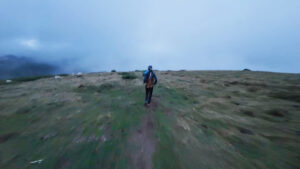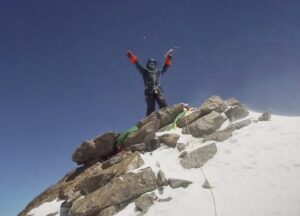In June 2019, alpinist and filmmaker Graham Zimmerman set out with his three climbing partners to take on an unclimbed face in the Karakorum: 7,041m Link Sar.
The rarely touched, never-before-summited Link Sar (M6+ Wi4 90°) soars 2,300m from Advanced Base Camp to the top. The exceptional undertaking earned Zimmerman and partners Steve Swenson, Mark Ritchy, and Chris Wright the Piolets d’Or.
Their time in Pakistan proved formidable from the very beginning of the three-month expedition. A “simple stumble” decommissioned Zimmerman’s left ankle only eight days in, relegating him to tent rest. Meanwhile, his partners forged a path to Advanced Base Camp.
Furthermore, conditions were not what they’d come to expect from previous trips to the Karakorum. The peak experienced one of the snowiest winters in memory, making avalanches even more likely than usual.

Photo: Graham Zimmerman
And that’s to say nothing of the mental acuity, physical endurance, and general fortitude that a deeply technical alpine route like Link Sar demands of those who court it. Or the inherent risk baked into the enterprise that is alpine mountaineering.
But when the accomplished alpinist and climate activist recalls their journey, none of those things seem at the forefront of his mind.
Zimmerman spoke to ExplorersWeb about his new film, which premiered earlier this month on EpicTV. His insights, ambitions, and perspective reach far beyond mountaineering.
Interview with Graham Zimmerman

Photo: Graham Zimmerman
This wasn’t your first time filming and climbing; you’re quite accomplished in the field. But how did you first begin doing these two hard things at once?
I started climbing 20 years ago, and you know, when I started, it was very much a ‘me’ thing. It was this thing that I was focused on, that I was enamored with. And I didn’t really care what anybody else thought — I didn’t think about it.
As I climbed more and saw all the resources I was putting into it, I started looking for ways in which I could create value for other people from my climbing. My climbing is still my climbing…but I started looking for ways to create a broader value than just my personal suffering.
Storytelling is the best way that I found to do that, and that began 10 or 15 years ago. I was just trying to capture experiences and share them. You know, inspire people to go climbing or do hard things.
And that developed into using the mountains as a tool for driving climate policy, and climate action, particularly around change within our government…And having that [visual] content when you tell those stories is super helpful.
I’ve done congressional addresses with [these videos]. I’ve done a bunch of federal lobbying efforts by meeting one-on-one with different senators and representatives. And I’ve spent a lot of time lobbying with the community and working with our local reps and county commissioners here in Central Oregon.
Building this film was fun for me because so much of what I do gets wrapped up in the climate or intersectional social justice, or supporting different organizations. But this film is just about why I love climbing, and about partnership.

Photo: Graham Zimmerman
You seem very bound to your people but also very dedicated to your objectives. How does that influence your approach to something that tests you as profoundly as Link Sar did?
For me, one of the most powerful parts of alpine climbing is the partnerships. And in the film, we explore my friendships and partnerships with Steve, Chris, and Mark while we’re up there on the route. But I hang out with those guys outside of climbing all the time.
Of course, there are goals to achieve great things for ourselves — and that’s something I think is really cool — but it’s just not the flavor of climbing that I’m into.
[If] we look at major innovations across the world, whether it’s the creation of the modern computer or modern medicine, these are all taking place between teams. And for me, climbing is the same way. As a team, we can be safer; we can have more energy and mental bandwidth to put towards an objective. And what comes from that are friendships and partnerships that are super intimate and powerful.

Photo: Graham Zimmerman
If you could pin down one significant moment of the experience within the context of the film, what would it be? Taking a 100-foot fall must have been intense.
The most powerful parts, for me, are those quick shots right at the end [of the film]. These [high-alpine] experiences are so intense. [Spending] nine days on this pretty real and serious route was amazing.
But when we look at what our actual goal on an expedition is, it’s to come home safe, to come home [as] friends, and to come home having summited, in that order.
When we came down, we had this moment before we went off and called our wives and girlfriends, before we disbanded from our own hyper-intimate team. There was this moment where we just kind of sat there for 15 to 20 minutes at Advanced Base Camp, and we were able to retain that intimacy.
Those shots that you see at the end were taken when we got down. It was like, we gotta hang on to that [moment]. We all made it down safely. We’re in one piece. We had summited. And we were able to kind of retain that really, really intimate partnership. That was special. Then we all went off and got on cell phones and started calling loved ones, so we kind of separated at that point.






